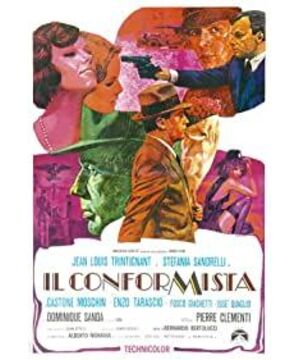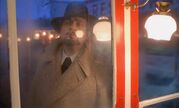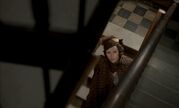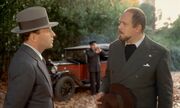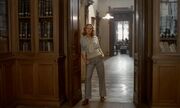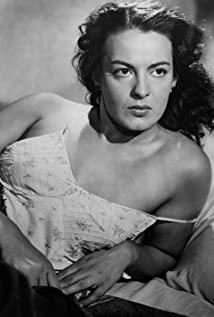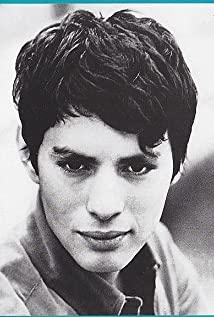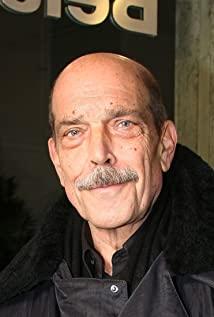(1) Centralized violence and faith crisis
The surface theme of "The Concurrent" is the imprisonment of human nature by centralized violence. The elements of order and freedom, violence and desire always appear in pairs in the film. Pasolini said in "The Movie of Poetry": "The expressive power of poetry comes from the symbol." There is an obvious introduction of external symbols in "The Concurrent". At the same time, Bertolucci also created an internal symbolic system, which eventually formed a very infectious poetic temperament and expressive power. The first system is "imprisonment"-in a scene where Marcello comes to his wife's house, the wife is dressed in a black and white striped dress, and the light is divided into countless strips by blinds. These elements all point to the meaning of imprisonment. The white curtains in the driver's room and the garlands at the blind party all give people the association of "blocking" and "death". There have been two direct appearances of the fence, namely, when Marcello came to his mother's house, received an assassination mission, and was finally thrown into prison...These images kept the protagonist in a depressive environment in which he was always behind bars, and hinted at the direction of the ending. Accompanied by it is the ubiquitous sense of "surveillance". The framed closed composition reinforces this atmosphere. Marcello came to the minister’s office to create a huge contrast between humans and machines with extreme perspectives and overhead perspectives, showing the smallness and oppression of people under a centralized system; the unbalanced composition of the characters at the bottom of the screen shows that humans are at extremes. A spiritual crisis of alienation and hollowness in the environment; three features of women barefoot reveal the corrupt, degenerate, spiritual, and moral lives of fascists and the bourgeoisie.
The extreme use of color in the film also clearly reveals this theme. The administrative buildings are all composed of black and white, orderly and coldly depressed. The use of blue in the film has multiple meanings, which are basically concentrated in the paragraphs in Paris. All the exterior scenes in Paris use a misty blue hue. The blue in the French tricolor flag stands for "freedom", but here it is more expressed as "the imprisonment of freedom by centralization", just as Kieslowski presented blue as "freedom and imprisonment" in "Blue" "The existence of this pair of propositions and contradictions is the eternal state of human existence. At the beginning of the film, a scene in which Marcello drove to the snow. The exterior shots and interior shots were all shrouded in gloomy blue lights, setting the tone of the melancholy and melancholic film. As the plot develops, it is given more and more Many rich connotations. A large area of white is used in the film to symbolize death and bad luck. The two scenes of being sexually assaulted and murdering Anna are full of killing and death, and they are also the saddest memories in Marcello's heart.
The film movement method is also very unique. There are almost no fixed-position static shots. Long shots are often used to match the rich scene scheduling. Among them, the use of zoom shots is particularly eye-catching. Althusser’s ideological criticism believes that “ideology is a state apparatus that asks individuals to enter order and become the subject”. This kind of interrogation is embodied in the bisecting shots commonly used in Hollywood movies-this is actually a "stitching system" that interrupts the audience's sight and provides another "narrator" to make it absent and conceal it. authority. The commonly used way of mirroring in "The Concurrent" is to enlarge the scene of the single shot to reveal the existence of the other. This not only deepens the perception of peeking, but also provides more space for thinking, embodies the depth-of-field lens advocated by the "window theory", and is rich in expressions. In this way, the film dispels the ideology and fits the theme appropriately.
Under the threat of centralized violence, another symbolic system "religious belief" in the film exposes its falsehood. Marcello’s prayer: “I want to pray for tomorrow’s crimes, to atone for sins.” It shows that religion is just a vain consolation to conceal the crime of peace of mind. The priest's ugly face and the cross in the pedophile's room all reveal the director's mocking attitude towards religion.
(2) Co-current and individuality
Bertolucci absorbed the elements of psychological realism movies, and showed a large number of the inner states of the characters' memories, fantasy, etc. in "The Contrastor". The film’s narrative structure: three parallel montages of time and space, with the timeline of Marcello’s assassination mission in Paris as the narrative axis, unfolding double memories. Most of the film takes a male subjective perspective. At the beginning, the rescue scene repeatedly flashed and buried suspense, and when the two plot lines met, the audience knew that he did not rescue, but stared coldly at Anna's death. This setting of time and space allows the audience to experience Marcello's mental journey through the triple time and space. The childhood memories scene first appeared with the same elements of "blocking the car" flashing, and then the content was officially expanded during prayer. This scene is both a flashback and a pre-narrative, based entirely on the protagonist's consciousness, with a stream of consciousness style.
Marcello is a two-sided fascist, but he is neither a utilitarian nor an idealist. The film spent a lot of pen and ink depicting his inner struggle. The interlaced flashing of red lights and natural light in the film's opening set his psychological tone-division. Wandering between the numb and cruel slaughter and individual desires, which leads to the second theme of the film-the instinct of the individual to suppress true desires and integrate into order. The audio-visual solution for Marcello’s role is to "split" the composition: his single shots are dominated by flashing colors, contrast of light and shadow, and the separation of obstacles. When he is in the same picture with others, he often uses highly contrasting shots. language. For example, when Marcello talks with the professor, the background color behind him and his wife is a sharp contrast of brown and white; the scene of accepting the task uses a horizontally inclined composition, which means that a major value shift has occurred in Marcello's heart; At the end of the film, there is a thick wall between Marcello and his wife before going out, and the two are always in a relationship that is in harmony and lack of soul communication.
One of the words that Marcello often said is "I want to live an ordinary life." The movie gives him the deep reasons for his desire to be "ordinary." The conversation with his father revealed the domestic violence he suffered during his childhood. Lacan’s psychoanalytic theory believes that in a patriarchal society, women in the eyes of men are incomplete, and the oppression of patriarchy brings “fear of castration” to men. The childhood trauma of being sexually assaulted further deepened this fear, making Marcello fear that he would become sexually disordered and "feminized." When he was insulted by his friends, he stopped the car to show off his uniqueness, but was eventually sexually assaulted. "Becoming an alien" became Marcello's deepest fear. As a result, Marcello desperately suppressed his true instincts and desires, and even joined a fascist organization, became a member of the "conspiracy" and accepted the violent rewriting of history.
However, Marcello's heart is always struggling, especially when he meets the professor and his wife. The discussion between him and the professor about Plato's "cave theory" showed that he longed for enlightenment and liberation, but he was afraid of becoming "an alien of truth." In the dream he described, his blindness was operated on by the professor, indicating that Marcello subconsciously agreed with the professor's thinking and hoped that he could "cure" himself. The setting of the two characters in the film has a mirrored relationship with Marcello: the role of the blind friend is unrealistic-slow to react and panicked. His first appearance was a mirror image composition with Marcello, and he said, "We are the same kind, we like the same people, and we don't trust different people." , He is confused and invisible. The two-color leather shoes show his confusion, black and white, and inverted position. Another character, Anna's appearance, awakened Marcello's remaining conscience and rational personality. "Any crazy love for him is narcissism," Marcello confessed to Anna in front of the mirror in the dance classroom. His obsession with Anna is a yearning for freedom and reason. The blue tone when the two embrace each other casts a poetic melancholy on this relationship, symbolizing the possibility of embracing freedom and breaking free. However, Marcello is a "comrade" after all. He prays and dances at the ball, all following the collective order. When he watched Anna being murdered, he also strangled himself and became a complete fellow. After the defeat, he saw the driver Li Nuo and immediately attributed himself astray to him, yelling to expose Li Nuo and his blind friends, trying to return to "ordinary" in peaceful times, but was finally overwhelmed by the parade. . This scene is exactly the same as the scene where Marcello was swallowed up in a whirlpool of dances at the ball, revealing the terrible collective unconsciousness. Reason is often overwhelmed by group carnivals, and individuals are always hostages held by history.
(3) Symbolic writing of historical trauma
"Fellow" is full of profound reflections on history and wars of the Italian post-war generation. The reference to the story in the film is full of ideology, alluding to the chaotic state of various forces in Italian society during World War II.
Marcello's father was imprisoned in a mental hospital, and the decline of patriarchy was the break of Italian history; the motherland symbolized by his mother became slutty, and the fornication with Japanese drivers meant that the Axis nations were gangsters; in this context, Fascism took advantage of the emptiness, incited the people, and engulfed people like Marcello who were vacillating; religion was just a vain lie, and the middle class (wife, mother-in-law) only followed it; when the only professor and couple who could cure the ills of society were killed , The entire country and all the people lost their sanity, joined the huge machine of the fascist regime, and became a part of this killing machine. Truth is fragile in the face of centralized violence, and is silent in the collective carnival. The herd mentality of people seeking advantages and avoiding disadvantages explains why fascist and other centralized regimes flourish, and is the source of collective violence.
In the passage in France, the country that was invaded, the director even sang the "Internationale" in the mouth of a flower girl, abused the fascists in the mouth of French women, and expressed a strong attack on fascism and totalitarianism.
"Family" exposes the historical trauma of the Second World War to the Italian masses. It speculatively expresses the deep collective consciousness of the Italian society after the war. It is a masterpiece of both ideology and artistry.
View more about The Conformist reviews


